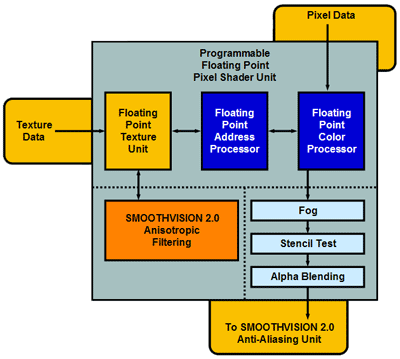ATI’s Radeon 9700 (R300) – Crowning the New King
by Anand Lal Shimpi on July 18, 2002 5:00 AM EST- Posted in
- GPUs
Eight Pixel Rendering Pipelines – The DX9 Era Begins
Part of the reason NVIDIA was able to extend such a large performance lead over the competition was their early adoption of an architecture that implemented four pixel rendering pipelines. This was back in 1999, two full years before ATI implemented four rendering pipelines in their R200 chip back in August of 2001.
![]()
This time around, ATI will be the first to jump on the next-generation bandwagon by outfitting the R300 with eight 128-bit floating point pixel rendering pipelines. This is a huge improvement over the four 64-bit integer rendering pipelines of the GeForce4 and Radeon 8500, and it also explains where a lot of those transistors went in the R300’s design. Not only did ATI double the number of rendering pipelines but they also doubled the precision and moved to a fully floating point pipeline to increase precision further. A fully floating point 3D pipeline will be a DirectX 9 requirement, and moving forward you’ll see the fastest DX9 parts employ a similar 8-pipe configuration.
The R300’s 8-rendering pipelines will give it a significant advantage in fill rate over anything currently available, also contributing to the R300’s performance lead over the competition.

The move to fully floating point pipelines is important as 3D graphics move towards higher fidelity. To illustrate the need for fully floating point pipelines let’s take a generalized situation where a floating point number is handed off to an integer pipeline:
If the original number being sent into an integer pipeline is 10.0523432543890, the number that actually gets sent to the pipeline is rounded or truncated so that it is a whole number. This simplification is not a problem if the result is being used to generate a relatively simple picture, but once you start creating photorealistic images then rounding errors like that can mean the difference between a scene that looks lifelike and one that is clearly computer generated.

An example of what's made possible through FP color.
Over the next year you will see a push from the hardware vendors to finally bring cinematic quality effects to the desktop.










0 Comments
View All Comments